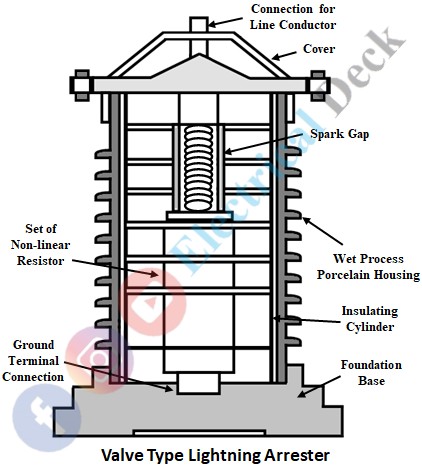A valve type lightning arrester is an improved and expensive lightning arrester which is also called a nonlinear surge diverter. A valve type arrester gets its name from the fact that a nonlinear resistor regulates itself from the flow of current and reduces the voltage when high surge currents occur. The nonlinear resistors make use of a material with the trade name thyrite, so this arrester is sometimes called a thyrite type lightning arrester.
Construction of Valve Type Lightning Arrester :
This arrester has two divisions. One is the series spark gaps while the other is the nonlinear resistor discs in series. Both these divisions are placed in a tight porcelain container to ensure reliable protection against atmospheric moisture, condensation, and humidity.
The spark gap is a combination of a number of identical spark gaps connected in series. Every spark gap has two electrodes with a fixed gap spacing. Additional resistance elements are used to cause uniform voltage distribution across the gaps.
The above shows the constructional details of the valve-type lightning arrester. The spacing of series gaps is provided in such a way that it withstands the normal circuit voltage. An overvoltage causes the gap to break down resulting in the surge current to ground through nonlinear resistors.
The non-linear resistor discs are made of an inorganic compound such as thyrite or metrosil and are connected in series. The resistance of these nonlinear resistors falls with a rise in current through them and vice-versa. They play an important role in limiting the high current flow.
Working of Valve Type Lightning Arrester :
At a normal system voltage, the valve arrester works like an insulator i.e., it does not cause the breakdown of air gap assembly. During overvoltage conditions, the series spark gap breakdown. And the nonlinear resistors offer a low resistance due to a high surge current.
As a result, the surge goes to earth instead of the line. The nonlinear resistors attain a high resistance to cease the flow of current when there is no surge. The volt-ampere characteristics of a nonlinear resistor are shown in the figure below.
The static and dynamic characteristics are represented by a dotted line and a dark line respectively. A horizontal tangent is drawn to the dynamic characteristic whose intercept gives the residual voltage. Residual voltage is the peak value of the voltage which occurs between the terminals of the surge diverter.
This occurs when the surge current discharges through the diverter. The voltage lies between 3 kV and 6 kV depending on the type of current discharge and rate of change of current. These arresters operate very fast and are effective in providing protection for devices like cables and transformers.
Classification of Valve Type Lightning Arresters :
The following are the types of valve-type lightning arresters based upon voltage and current capacity.
Station Type Lightning Arresters :
Station type lightning arresters are the most efficient and costly lightning arresters. They have greater surge-current withstand strength and have a greater margin of protection. This type of lightning arrester is mainly employed in higher voltage systems.
The name itself indicates their general application in power stations. It has the highest capacity for energy dissipation. The peak discharge current that can carry is 10 kA while its voltage range for operation is 3.3 kV to 245 kV (RMS).
Line Type Lightning Arresters :
These arresters are mainly used for the protection of large transformers, intermediate substations, and medium and large power stations. They are smaller than station transformers. The standard discharge current carried safely by them is about 5 kA while the working voltage range is 33 kV to 123 kV (RMS).
Distribution Type and Secondary Type Lightning Arresters :
This type of arrester is employed for the protection of distribution transformers against overvoltages. The standard peak discharge current for its operation is 2.5 kA and 1.5 kA. While its voltage range is up to 3.3 kV (RMS).



